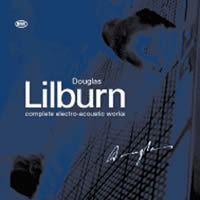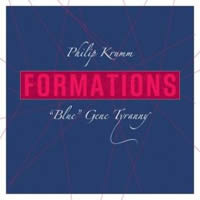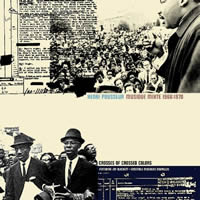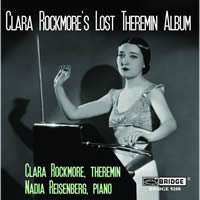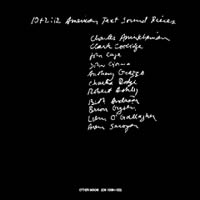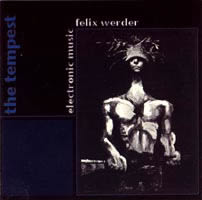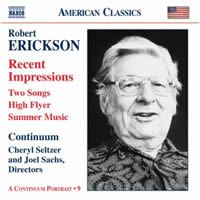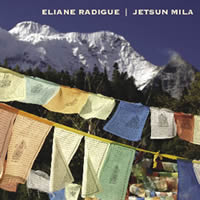EA Bucket 6: Historic Releases
|
Grant Chu Covell [August 2007.]
“Complete Electro-acoustic Works.” Douglas LILBURN: Var. comp. atoll ACD 404 (http://www.atollcd.com/). Distributed in the US by Forced Exposure (http://www.forcedexposure.com/). Lilburn (1915-2001) had two compositional careers. In 1936 he won a contest sponsored by Percy Grainger which enabled him to study composition with Vaughan Williams at London’s Royal College of Music. Returning to New Zealand, he taught and influenced his country’s musical life. A pair of Naxos releases ably presents his orchestral works. Lush overtures and tone poems in the Sibelius and Nielsen vein are on Naxos 8.557697, and his three unsung symphonies (1949, 1951, 1961) are on Naxos 8.555862 (reviewed here). From the mid-1960s onward, Lilburn’s output was predominantly electro-acoustic. He became fascinated with the medium, characterizing his work with it as akin to painting. His last ea pieces date from 1979; as his hearing diminished, he stopped composing in the mid-80s. Atoll’s set of three CDs and one DVD captures Lilburn’s extant ea compositions. They aren’t presented chronologically, thus making development difficult to trace. In 1963 Lilburn visited ea studios in Darmstadt, London and Toronto, absorbing the medium’s possibilities. He would return to New Zealand and fashion complex, poetic works with limited equipment, beginning with the 17-minute radiophonic The Return (1965). The 1967 Study from One Note applies a complete set of studio skills (pitch shifting, reverb, reversal, etc.) to a single kokako’s chirp. The Three Studies for Gustav Ciamaga (1969) recall French GRM études. Three Inscapes (1972) maximizes the Putney VCS3, an early voltage-controlled synthesizer. While the sine wave blips and characteristic squawks sound antiquated today, Lilburn’s extended structures were advanced for his time. Skipping through the collection, the eerie Winterset (1976) and humorous Carousel (1976) stand out. Poem in Time of War (1967) has the most overt program, deftly transforming a gentle folksong into modulated screeches and gritty whining. Not merely because I have trouble reconciling his ea style with his Romantic orchestral works, I wonder what Lilburn would have done with present-day ea equipment. The DVD contains film clips and four-channel versions of Lines and Distances (1975) and Sounds and Distances (1975). We see Lilburn in the Victoria University Electronic Music Studio in 1970 (dressed in white shirt and dark tie) discussing how he created some of the material in Dance Sequence — Expo 70. There are also brief reminiscences of Ralph Vaughan Williams, “VW,” captured in 1972. Stills reproduced in the booklets accompany Glass Music, an audio collage of simply processed, variously constructed chimes. The set finishes with an audio interview in which Lilburn expresses admiration for Nono.
Philip KRUMM: Formations (1968/69). “Blue” Gene Tyranny (pno, org, computer), Dan Cheslik (pno, org). Idea 2007 (http://www.idearecords.com/). Distributed in the US by Forced Exposure (http://www.forcedexposure.com/). Henri POUSSEUR: Crosses of Crossed Colors (1970); Jeu de Miroirs de Votre Faust (1966/67). Sub Rosa SR231 (http://www.subrosa.net/). Distributed in the US by Forced Exposure (http://www.forcedexposure.com/). A 20:21 release laminates two 1968 tapings of Krumm’s Formations for piano, organ and ring modulator over the muted static of “universal microwave background noise from the South Galactic Pole.” Both Tyranny and Krumm orbited between Fluxus and Cage, creating, programming and performing avant-garde music. Formations ripples with agitated, quasi-serial gestures and ring modulation’s oppressive tartness: a sandy mouthful interrupting a beach picnic. Dedicated “in memoriam Martin Luther King,” Pousseur’s Crosses of Crossed Colors combines voice, anywhere between two and five pianos, and six operators at two tape decks, two turntables and two radios. Texts are by Michel Butor. Sub Rosa presents its first release from a 1972 concert. Joy Blackett is the featured soprano and the Belgian “Ensemble Musiques Nouvelles” includes Pierre and Francette Bartholomée, Wieland, Sigiswald and Marlène Kuijken, Robert Leuridan, and Philippe Boesmans. This is surprising repertoire for the Kuijkens! It’s all too easy to name Cage as an influence; however, the political content and explicit references to current events express an activist’s viewpoint completely Pousseur’s own. Both Crosses and Jeu de Miroirs de Votre Faust recycle material from previous works: Couleurs croisées (1967) and Pousseur’s grand opera Votre Faust (1961-68) respectively. A pure tape composition, Jeu de Miroirs blends a recording of an earlier Votre Faust spin-off for piano and soprano, Miroir de Votre Faust (1964-65, performed by Marcelle Mercenier and Basia Retchitska) with bits from the opera’s tape parts, including author Butor reciting. Pousseur’s piano part sneaks in bits from other operas and music, which may have influenced Cage, whose first Europeras didn’t appear until 1987. Owing to Pousseur’s virtuosity and wit, these oldies stand well apart from today’s hash.
“Clara Rockmore’s Lost Theramin Album.” Var. composers, compositions. Clara Rockmore (theramin), Nadia Reisenberg (pno). Bridge Records 9208 (http://www.bridgerecords.com/). “10 + 2: 12 American Text Sound Pieces.” Var. composers. Other Minds OM 1006-2 CD (http://www.otherminds.org/). Distributed in the US by Allegro Music (http://www.allegro-music.com/). In 1975 Bob Moog persuaded Clara Rockmore and her sister Nadia Reisenberg to make recordings. Moog had just reconstructed Rockmore’s five-octave theramin built for her by the instrument’s inventor, Leon Theramin. Rockmore, originally a violin prodigy who had studied with Auer, was 64 and Reisenberg 71 when Moog documented them. Twelve tracks were released in 1977 by Delos (DE 1014), along with three others in a collection commemorating Reisenberg. The remainder were unpublished until now, hence the “lost” designation. With the support of Rockmore and the Reisenberg family, Bridge has released 16 tracks. (The three that appeared in the Reisenberg collection now have different accompaniments.) Does the world really need more theramin music? Perhaps not, yet taking into account that playing the instrument requires waving both hands in the air to guide dynamics and pitch, Rockmore’s artistry astounds. The corny, generally salon-ready vignettes are well suited to the theramin’s sinewy rasp: Louis Louiguy’s La Vie en Rose, Gershwin’s Summertime, Schubert’s Ave Maria, Dvorak’s Humoresque, etc. Definitely a disc to blend into the Ondes Martenot, Esquivel and Spike Jones party mix. Other Minds reissues a classic 1975 LP enshrining a skilled generation’s adventures with text, back in the days when such work was groundbreaking. Charles Amirkhanian’s 1972 Just and 1973 Heavy Aspirations open the collection. Just amiably jazzes with the rhythmic possibilities of four words, masterfully layering and repeating “rainbow,” “chug,” “bandit” and “bomb.” Heavy Aspirations extends Just’s sensibility onto larger phrases extracted from a lecture by the endearingly thick-accented Nicolas Slonimsky. There are excerpts from Charles Dodge’s landmark 1972 Speech Songs, Robert Ashley’s In Sara, Mencken, Christ and Beethoven There Were Men and Women (1972-73), and Beth Anderson’s Torero Piece (1973). Thirty-five years on, amidst works employing humor and rich technique, Cage’s 62 Mesostics Re Merce Cunningham (1971) sounds the dullest of the lot. Cage’s mesostics require performance technique, and Jack Brice’s vocal part lacks the emotional range and shock value of other tracks, e.g., John Giorno’s 1967 Give it to Me, Baby, which alternates pornography, real-estate ads and mundane texts. Brion Gysin’s 1962 Come to Free the Words captures the poet reciting while writing with chalk. One imagines the letters being drawn as he writes. Liam O’Gallagher’s 1970 Border Dissolve in Audiospace is an extended prank involving calling telephone operators and asking them to look up a phone number. Remember that? The original LP contained two pieces in the “lock grooves,” the side’s ultimate track where the needle circles forever until physically stopped. For CD issuance Anthony Grazzo’s The Population Explosion (1969) and Aram Saroyan’s crickets (1965) have been looped for several minutes to recreate the experience.
Felix WERDER: Banker (1973); The Tempest (1974); Oscussion (1971); V/Line (1992, realized by Warren Burt). Pogus P21044-2 (http://www.pogus.com/). Robert ERICKSON: Recent Impressions (1987); Two Songs (1986); High Flyer (1969); Summer Music (1974). Continuum. Naxos 8.559283 (http://www.naxos.com/). Yet again, Pogus brushes away cobwebs from ea’s not-so-distant past. Werder’s family fled Germany in the ’30s, arriving in Australia via England. He became deeply involved in Australian musical life. This disc’s first three pieces, lovingly restored from aged LPs by Warren Burt, are blippy and raucous contraptions. Banker’s plot refers to Aeschylus’ Agamemnon, but I cannot make the connection to the eight sections identified in the notes. No worries, however, about plot requirements: The synthesizers, percussion, guitar and piano blend into a fascinatingly gnarled fabric. The synthesizers don’t play scales or traditional keyboard-like material, quite unlike Mother Mallard’s Portable Masterpiece Co., preferring dreamy atonal washes. Piano, percussion and guitar punch through the haze with sparky gestures. At 28:20, Tempest is the longest piece here, an abstract rumination on Giorgione’s ambiguous “La Tempesta” built on the legendary EMS Synthi 100. With shifting panels of sound and mood, Oscussion combines two synthesizers with percussion ensemble. Strange to say, if Webern had lived a few more decades and felt the need to write large pieces (Banker is 21:24 and Oscussion 17:48), I suspect they’d sound like these. Jumping ahead two decades, V/Line is an odd MIDI construction, assembled by Burt from score, with timbres suggesting real instruments except for the tricky lines and frequent noise blasts — a computer-generated Schoenberg Chamber Symphony. Erickson may not be a household name, though several of his students, Morton Subotnick, Terry Riley and Pauline Oliveros, have attained places in New Music’s Pantheon. Naxos recycles 1988 and ’89 Musical Heritage Society recordings in its ongoing “Continuum Portrait” series. While Summer Music is the disc’s sole occupant containing anything explicitly electronic, the other works reflect a composer deeply mindful of ea. Summer Music pairs solo violin, played by Mia Wu, with a tape consisting mostly of processed water sounds. Erickson filtered gently burbling brooks captured at the Sequoia National Park, emphasizing particular pitches which the violin echoes in long wispy lines. A contemplative mood replaces customary high-strung virtuosity. High Flyer for solo flute requires the flautist to talk, thus marring syllabic clarity, an effect not unlike garage-band amplification. Recent Impressions and Two Songs for large ensemble concentrate on changing timbres, especially in the thinly textured Recent Impressions which requires precisely controlled ensembles to spin slow lines.
Eliane RADIGUE: Jetsun Mila (1986). Lovely Music CD 2003 (http://www.lovely.com/). Finally, we come to Lovely’s CD reissue of Radigue’s 84-minute epic on the life of Milarepa, the 11th-century Tibetan yogi and poet. The work’s prelude and nine sections progress seamlessly through fields of rich droning, earthly rumbles and occasional repetitive tingling. Meditative and minimal will suffice as descriptions. You might find it strange that someone who worked side by side with Schaeffer and Henry at ea’s infancy would build such grand and leisurely spans. Indeed Henry was unhappy with Radigue’s early explorations of electronic feedback. Lovely has released what was originally issued on cassettes as two CDs: 44:24 + 39:56. A DVD release would have produced a seamless blanket.
[More EA Bucket, Grant Chu Covell]
[Previous Article:
Words Fail Me 1.]
[Next Article:
Words Fail Me 2.]
|
